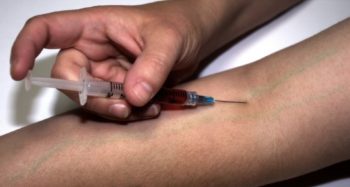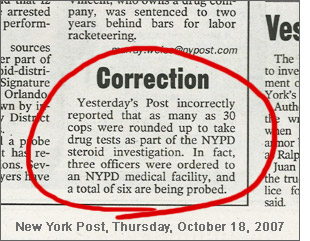
(Credit: PIxabay)
The New York Post’s statistics should be checked for steroid use.
In an October 17th article on an investigation into steroid use by New York City police officers, The New York Post gave a beefed up figure of 30 cops from the NYPD being tested.
That number deflated to three in a page 4 correction of the article. According to Deputy Commissioner Paul J. Browne in a NYPD release, “Six police officers are being investigated for the possible improper use of prescriptions to obtain anabolic steroids for non-medical, personal use. Three of those six have been tested.”
Yet the error persists in the Post’s online edition. Even though the text now correctly states “Six cops are under investigation,” the headline continues to be wrong. Instead of “three cops tested,” the headline says “six cops tested.”
As Craig Silverman from the blog Regret The Error has pointed out, The New York Post has no section in the online version of the newspaper that keeps tabs of their errors. So if you don’t pick up the print edition, you’re likely to only read about it here.

Rhonda Roland Shearer, iMediaEthics’ publisher, contacted the Post for comment. She asked if they intend to make their corrections transparent by creating an online corrections page and appending corrections to the original articles in all the databases that carry Post content, such as LexisNexis. As of the publication of this article, the paper has not returned her call.
In addition, I contacted journalist Larry Celona, whose name appears on the byline, for a statement. My email has not been answered.
In a prepared statement, Deputy Commissioner Brown said, “Once more, purported ‘sources’ have provided grossly exaggerated information that wildly distorted the facts of an IAB [Internal Affairs Board, ed.] investigation.”
His statement raises a hot-button issue for many journalists: the use of anonymous sources. Even two of the dailies that got the facts straight, The New York Times and the New York Daily News, relied heavily on unidentified tipsters. Here are the tallies:
| ANATOMY OF ANONYMITY
The New York Times
“police said” → 3 times “investigators said” → 2 times “law enforcement sources said” → 1 timeThe New York Daily News “source(s) said/told” → 4 times “law enforcement source(s) said” → 2 times “Investigators believe” → 1 times “Cops believe” → 1 time |
Neither publication explained the reasons these people requested and were granted anonymity. This is in direct contradiction to the policy of the New York Times stated in its 2005 report “Preserving Our Readers’ Trust.” “When anonymity is unavoidable, reporters and editors must be more diligent in describing sources more fully. The basics include how the anonymous sources know what they know, why they are willing to provide the information and why they are entitled to anonymity.”
Crime reporting is an extremely competitive field of journalism, in which the thirst for a “scoop” often trumps fact-checking. Professors Karen Slattery and Mark Doremus commented on this trend in response to a story we filed about the New York Daily News coverage on the death of a 5-year-old girl from the Bronx.
Using our case study of the dangers of relying on anonymous sources for crime reporting, they argued that news outlets need to be more careful about who they rely on for information.
It’s a lesson that applies here – and one worth reiterating.
| October 17 Press Release from Deputy Commissioner Paul J. Browne
The New York Post erroneously reported this morning that as many as 30 police officers had been tested for possible steroid use when, in fact, only three were. Once more, purported “sources” have provided grossly exaggerated information that wildly distorted the facts of an IAB investigation, in which six police officers are being investigated for the possible improper use of prescriptions to obtain anabolic steroids for non-medical, personal use. Three of those six have been tested; another three are expected to be tested. Results of the tests are pending. A pharmacy employee has been arrested in connection with the investigation. While the officers’ conduct being investigated could result in disciplinary action, no arrests of police officers are anticipated. -Deputy Commissioner Paul J. Browne |






Comments Terms and Conditions